|
|
Progress on Large-area Organic-inorganic Hybrid Perovskite Films and Its Photovoltaic Application
ZHANG Hui, XU Zhipeng, ZHU Congtan, GUO Xueyi, YANG Ying
2024 Vol. 39 (5): 457–466
 Abstract
Abstract(
379 )
 HTML
HTML(
28)
 PDF
PDF(2388KB)(
588
)
Recently, organic-inorganic hybrid perovskite solar cells have demonstrated a broad commercial prospect due to their high photoelectric conversion efficiency (PCE) and low fabricating costs. During the past decades, the highest reported PCE of small-area (<1 cm2) perovskite solar cells (PSCs) rose to 26.10%, and those of large-area (1-10 cm2), mini-module level (10-800 cm2) and module level (>800 cm2) PSCs increased to 24.35%, 22.40% and 18.60%, respectively. The performance of PSCs decreases dramatically with the area increasing due to limitation of the deposition method and the poor quality of large-area perovskite films. Spin-coating method is not suitable for actual industrial production, while the scalable deposition methods including blade-coating and slot-die coating still face the difficulty of precisely controlling nucleation and crystallization of the perovskite films with large area. This review summarized preparation methods of large-area perovskite films, and discussed the film-forming mechanism and strategies for high-quality perovskite films. Finally, relevant outlooks on technologies and applications for large-area PSCs with high performances and stabilities were analyzed. This review is expected to provide insights on the research of large-area PSCs with high performance.

|
|
|
Ni-Co-B-RE (Sm, Dy, Tb) Composite Electrodes: Preparation by Chemical Deposition Method and Electrocatalytic Hydrogen Evolution Performance
JING Xinxin, CHEN Biqing, ZHAI Jiaxin, YUAN Meiling
2024 Vol. 39 (5): 467–476
 Abstract
Abstract(
143 )
 HTML
HTML(
9)
 PDF
PDF(5438KB)(
355
)
Developing low-cost, high-activity non-precious metal electrocatalysts is of great significance for the practical application of water electrolysis. Rare earth (RE) elements have become a research hotspot for the modification of metal catalysts due to their unique electronic structures. However, the methods for preparing rare earth composite catalysts on nickel foam (NF) substrates are demanding, presenting issues such as high cost, complex processes, and long production time. This research employed a straightforward chemical deposition technique to fabricate rare earth composite electrodes on NF substrates. The structure and morphology of the catalytic electrodes were characterized, and their hydrogen evolution performances in 1 mol·L-1 KOH solution were investigated. The results revealed that adding Sm, Dy, and Tb could alter the electronic structure of the electrodes, improve the intrinsic properties of the catalyst materials, and enhance the catalytic performance for hydrogen evolution reaction (HER). Ni-Co-B-Tb/NF displayed superior hydrogen evolution performance with an overpotential of only 58 mV at a current density of 10 mA·cm-2 and a Tafel slope of 65 mV·dec-1. HER was controlled by the Volmer-Heyrovsky step. It was found that the variation of rare earth concentration had great effect on the electrocatalytic performance. When the Tb concentration was 3 g·L-1, smaller size and uniformer distribution of particles on the surface of Ni-Co-B-Tb/NF exposed more active sites, which was favorable for HER charge transfer, and the best performance of hydrogen evolution was achieved. Furthermore this catalyst exhibited remarkable electrochemical stability following an extensive 100 h stability test and 2000 cyclic voltammetry (CV) testing.
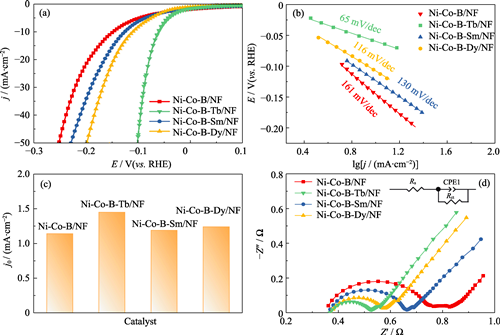
|
|
|
Organic-inorganic Co-addition to Improve Mechanical Bending and Environmental Stability of Flexible Perovskite Solar Cells
CHEN Tian, LUO Yuan, ZHU Liu, GUO Xueyi, YANG Ying
2024 Vol. 39 (5): 477–484
 Abstract
Abstract(
204 )
 HTML
HTML(
5)
 PDF
PDF(3806KB)(
181
)
Recently, perovskite solar cells have developed marvelously of which power conversion efficiency (PCE) achieved 26.1%, but the mechanical bending and environmental stability of flexible perovskite solar cells (F-PSCs) have remained major obstacles to their commercialization. In this study, the quality and crystallization of perovskite thin films were enhanced by adding agarose (AG). The interaction mechanism, PCE, mechanical bending and environmental stability of the assembled F-PSCs were investigated. It was found that the perovskite films modified by the optimal concentration of AG (3 mmol/L) exhibited denser and smoother morphology, higher crystallinity and absorbance, the lowest defect state density, and lower charge transfer resistance of 2191 Ω. Based on the optimal photoelectric properties, PCE increased from 15.17% to 17.30%. TiO2 nanoparticles (0.75 mmol/L) were further introduced to form a synergistic interaction with AG (3 mmol/L), which provided a rigid backbone structure, and thus enhanced the mechanical and environmental stability of perovskite layers. After 1500 cycles of bending (3 mm in radius), the AG/TiO2 co-modified F-PSCs maintained 84.73% of initial PCE, much higher than the blank device (9.32%). After 49 d in the air, the optimal F-PSCs still maintained 83.27% of initial PCE, superior than the blank device (62.21%). This work provides possibility for preparing highly efficient and stable F-PSCs.
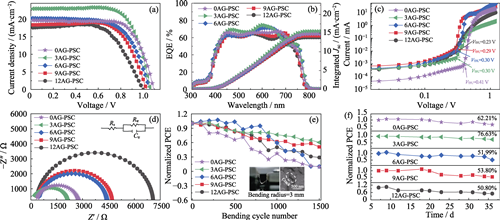
|
|
|
ZnCo2O4-ZnO@C@CoS Core-shell Composite: Preparation and Application in Supercapacitors
YANG Endong, LI Baole, ZHANG Ke, TAN Lu, LOU Yongbing
2024 Vol. 39 (5): 485–493
 Abstract
Abstract(
200 )
 HTML
HTML(
9)
 PDF
PDF(1586KB)(
258
)
Supercapacitors, distinguished by their unique advantages, including high power performance, stable cycling behavior, and excellent safety, emerge as highly promising energy storage devices in the fields of new energy vehicles and mobile electronic applications. However, the issue of relatively low energy density continues to constrain their practical applications. To enhance electrochemical activity, CoS nanosheets were deposited onto ZnCo2O4-ZnO microspheres coated with carbon (ZCO-ZO@C@CoS) using a facile solvothermal method, calcination treatment, and electrochemical deposition reaction. Carbon layer not only promoted electron transport to enhance electrical conductivity, but also improved the stability of the structure. The open network space formed between CoS nanosheets facilitated rapid ion transport. Additionally, CoS nanosheets possessed abundant electroactive sites, enabling rapid reversible redox reactions. The co-effect of nanowires of the core-shell structure, the carbon layer, and the outer nanosheets effectively enhanced the overall electrochemical performance. Consequently, ZCO-ZO@C@CoS exhibited a specific capacitance of 1944 F·g-1 (972.0 C·g-1) at 1.5 A·g-1, with an initial capacity retention of 75% after 10000 cycles at high current density of 20 A·g-1. The asymmetric supercapacitor device, comprising ZCO-ZO@C@CoS (positive electrode) and activated carbon (negative electrode), also demonstrated excellent specific capacitance, high-rate performance, and exceptional cycling stability, indicating significant potential for practical applications.
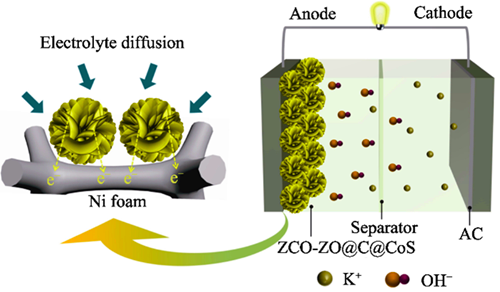
|
|
|
Damage of 2D-SiC/SiC Composites under Projectile Impact and Tensile Properties after Impact
LI Guangyu, YUE Yifan, WANG Bo, ZHANG Chengyu, SUO Tao, LI Yulong
2024 Vol. 39 (5): 494–500
 Abstract
Abstract(
160 )
 HTML
HTML(
4)
 PDF
PDF(2937KB)(
225
)
Continuous fiber-reinforced ceramic matrix composites are widely used for high temperature components like aerospace engines due to their superior performance at elevated temperature. However, these materials are susceptible to damage from foreign object debris during service, which has become a significant concern. To investigate the impact damage characteristics of 2D-SiC/SiC composites, this study utilized a light gas gun to subject specimens prepared using chemical vapor infiltration (CVI) technology to ballistic impact. The impact processes were recorded with a high-speed camera, while the surface and internal structures of foreign object damage (FOD) were examined by optical microscopy and computed tomography (CT). This investigation revealed that conical cracks, interlaminar delamination, fiber fracture, and matrix collapse were the primary manifestations of high-speed impact damage. Damage characterization indicated that backside damage and edge delamination damage were caused by reflected tensile waves. As the impact velocity increased, the combined action of the projectile and tensile waves resulted in specimen penetration and weakening of edge delamination damage. Quasi-static tensile tests on high-speed impact specimens elucidated the relationship between residual mechanical properties and impact velocity, as well as projectile diameter. The results showed that residual tensile strength was a crucial parameter indicative of the severity of impact damage. Additionally, digital image correlation (DIC) was employed to determine strain distribution during tensile processes. By integrating residual tensile strength after impact with different projectile diameters and impact velocities, the study further explored the effect of varied parameters on impact damage. The research findings highlighted that projectile diameter as the primary factor influencing the extent of high-speed impact damage.
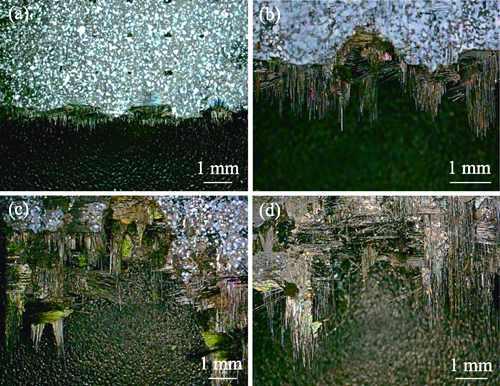
|
|
|
Sintering Behavior of Simulating Core FCM Fuel via Hot Oscillatory Pressing
HE Zongbei, CHEN Fang, LIU Dianguang, LI Tongye, ZENG Qiang
2024 Vol. 39 (5): 501–508
 Abstract
Abstract(
135 )
 HTML
HTML(
8)
 PDF
PDF(2798KB)(
179
)
Fully ceramic micro-encapsulated (FCM) fuel has become the focus of nuclear energy research because of its good inherent safety. In order to overcome the difficulty of SiC matrix densification, this study focused on the sintering behavior of simulating core FCM fuel via hot oscillatory pressing (HOP), taking the advantages of HOP to accelerate mass transfer and reduce sintering temperature. The influence of oscillatory sintering temperature, oscillatory time and oscillatory pressure on the matrix densification behavior was studied, and the results were compared with those of hot pressing (HP). The results indicate that the oscillatory sintering temperature, holding time, and median pressure have important effects on matrix densification, while the amplitude of oscillatory pressure has little effect. Compared with HP, the density of the samples is increased by HOP, and the density of sample sintered at 1850 ℃ via HOP is 99.99%. The grain size of the samples via HOP is smaller, and the grain size of the sample sintered via HOP at 1850 ℃ is (284±4) nm, which is ~27% less than that of the sample sintered via HP at the same temperature. The hardness of the samples sintered via HOP is higher, and the hardness of the sample sintered via HOP at 1850 ℃ is (26.7±0.4) GPa. When the density of sample is 90%, the stress exponent n=1 and activation energy Q=430 kJ/mol are obtained by using the modified constitutive equation of HP. The dominant mechanism of densification is grain boundary sliding, which is accommodated by the grain boundary diffusion.
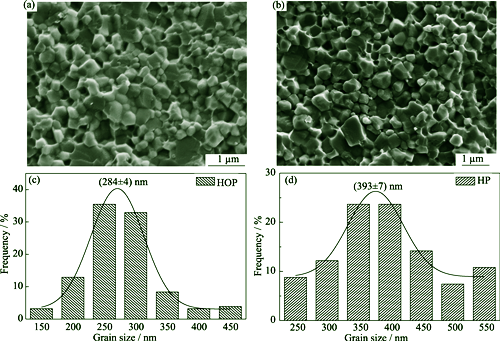
|
|
|
Flame-retardant Properties and Transformation of Flame-retardant Mechanisms of EVA: Effect of ATH/ADP Ratio
CHENG Bo, AN Xiaohang, LI Dinghua, YANG Rongjie
2024 Vol. 39 (5): 509–516
 Abstract
Abstract(
162 )
 HTML
HTML(
8)
 PDF
PDF(2920KB)(
209
)
To improve the flame-retardant properties of ethylene-vinyl ecetate copolymer (EVA) with aluminum hydroxide (ATH), a blend of aluminum diethylphosphite (ADP) and ATH was used. The flame-retardant properties of the composites were evaluated by using vertical burning (UL-94), limiting oxygen index (LOI), and cone calorimeter (CONE) tests. The results indicated that at the mass ratio of ATH to ADP of 2∶1 and 1∶2, compared to the EVA/ATH composites, the vertical burning rating improved from no rating to V-0, and the LOI increased from 34.5% to 37.8% and 42.8%, respectively. Different methods were used to analyze the flame-retardant mechanisms of samples with these two ratios. For the sample with a mass ratio of ATH to ADP of 2∶1, the content of phosphorus-containing compounds released during thermal decomposition was extremely low, and the formation of aluminum phosphate (AlPO4) strengthened the char layer, made it more continuous and dense, resulting in higher residue mass than theoretical value. Therefore, the proposed flame-retardant mechanism at this ratio is dominated by the condensed phase. For the sample with a mass ratio of ATH to ADP of 1∶2, the char layer had more pores, and the residue mass was lower than theoretical value, but high content phosphorus-containing compounds appeared in the gaseous products. Hence, the proposed flame-retardant mechanism at this ratio is dominated by gas phase.
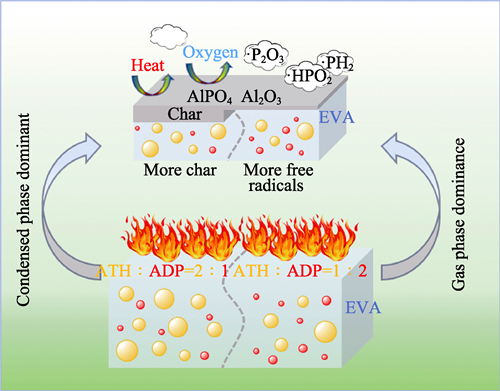
|
|
|
Fe3O4-DMSA-PEI Magnetic Nanoparticles with Small Particle Size: Preparation and Gene Loading
CAI Heqing, HAN Lu, YANG Songsong, XUE Xinyu, ZHANG Kou, SUN Zhicheng, LIU Ruping, HU Kun, WEI Yan
2024 Vol. 39 (5): 517–524
 Abstract
Abstract(
179 )
 HTML
HTML(
8)
 PDF
PDF(2256KB)(
313
)
Ferroferric oxide (Fe3O4) magnetic nanoparticles are widely used as passive targeting carriers in gene therapy, due to their simple preparation, targeting under external magnetic field and easy surface grafting. This study synthesized oil phase Fe3O4 nanoparticles with controllable particle sizes in the range from 4 to 9 nm by regulating the accumulation growth time in the solvothermal method. Then, meso-2, 3-dimercaptosuccinic (DMSA) was employed to double exchange oleic acid molecules on its surface to provide good water dispersibility. Finally, Fe3O4-DMSA-PEI magnetic nanoparticles were obtained by grafting branched polyethylenimine (PEI) onto Fe3O4-DMSA surface through amidization reaction. The results demonstrate that the Fe3O4-DMSA-PEI magnetic nanoparticles have a surface Zeta potential of (52.50 ± 1.94) mV, remaining a certain degree of superparamagnetism (14.48 emu/g, 1 emu/g=1 A∙m2/kg). When the mass ratio of Fe3O4-DMSA-PEI magnetic nanoparticles to plasmid DNA is 15 : 1, it can completely block DNA and its loading capacity is as high as 6.67%. The Fe3O4-DMSA-PEI magnetic nanoparticles prepared in this study have a certain gene delivery ability and are expected to be used as gene carriers in the field of gene transfection.
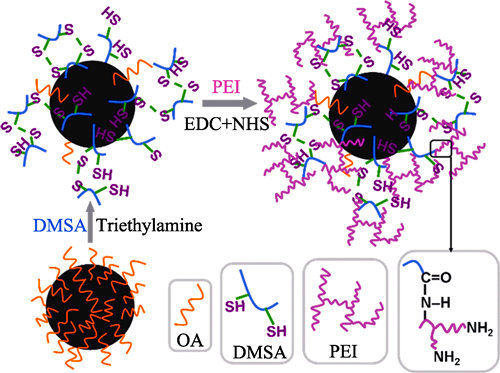
|
|
|
Preparation and Optical Properties of Sol-Gel SiO2 Antireflective Films
SHEN Bin, ZHANG Xu, XIONG Huai, LI Haiyuan, XIE Xinglong
2024 Vol. 39 (5): 525–530
 Abstract
Abstract(
162 )
 HTML
HTML(
4)
 PDF
PDF(710KB)(
202
)
Base-catalyzed sol-gel porous SiO2 antireflective film, an important part of high power laser (such as "Shenguang II" high power laser) facilities, has excellent optical properties and laser damage resistance. However, its low binding strength with optical components can lead to the film frustrated with contact destruction. Based on this antireflective film, a double-layer SiO2 antireflective film (SiO2-MTES) was prepared with improved mechanical strength by coating a thin dense SiO2 film on its surface using dip coating method. Then the SiO2-MTES was compared with a commonly used single-layer ammonia cured SiO2 antireflective film (SiO2-HMDS). Results indicate that the peak transmittance of the fused quartz substrate coated with SiO2-MTES reaches greater than 99.6% at about 800 nm and the zero probability laser damage threshold is measured to be 51.9 J/cm2 (1064 nm, 9.1 ns) by 1-on-1 laser induced damage threshold testing method, equivalent to the performances of the fused quartz substrate with SiO2-HMDS. Meanwhile, the contact angle between SiO2-MTES and water reaches 117.3°, and the transmittance stability of the SiO2-MTES is good in the high humidity environment with relative humidity greater than 90%. Results of multi-wiping experiments show that the friction-resistant mechanical strength of SiO2-MTES is significantly better than that of SiO2-HMDS, which effectively improves the binding strength between the film and the optical components.

|
|
|
Effect of MgF2 Additive on Preparation and Optical Properties of MgAl1.9Ga0.1O4 Transparent Ceramics
LÜ Zhaoyang, XU Yong, YANG Jiuyan, TU Guangsheng, TU Bingtian, WANG Hao
2024 Vol. 39 (5): 531–538
 Abstract
Abstract(
143 )
 HTML
HTML(
5)
 PDF
PDF(4832KB)(
190
)
Currently, the preparation of MgAl1.9Ga0.1O4 transparent ceramics which possess excellent optical properties, is still relying on combining aqueous gel-casting and prolonged pressureless pre-sintering. In this work, MgF2 was used as a sintering additive, and densification process of pressureless pre-sintering was adjusted by a transient liquid phase. MgAl1.9Ga0.1O4 transparent ceramics with different sizes were prepared by dry pressing, pressureless pre-sintering, and hot isostatic pressing treatment. The effects of MgF2 additive on microstructure, optical, and mechanical properties of the samples were systematically analyzed. The results indicated that MgF2 melted at ~1230 ℃, contributing to increase of density and grain size of the pre-sintered body, while the residual MgF2 was oxidized to MgO and dissolved into the MgAl1.9Ga0.1O4 lattice in the subsequent sintering process. The 2.04 mm thick transparent ceramic sample with 0.20% (in mass fraction) MgF2 has an in-line transmittance of 76.5%-83.4% in the UV and visible regions. Moreover, the sample has high optical quality with low scattering on incident light. In addition, the characteristic flexural strength of this ceramics is 167.1 MPa, which is close to that of the fine-grained MgAl2O4 transparent ceramics, but the Weibull modulus (8.81±0.29) is higher. This study provided a new option for the preparation of large MgAl1.9Ga0.1O4 transparent ceramic materials with good optical properties.
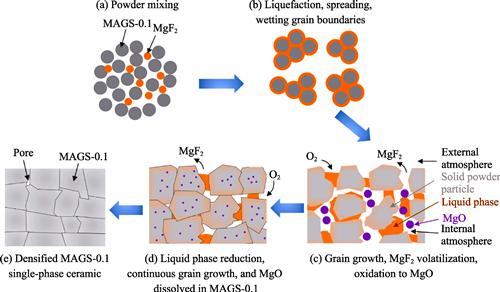
|
|
|
Effect of Zr4+ Co-doping on Neutron/Gamma Discrimination of Cs2LaLiBr6:Ce Crystals
ZHENG Zhongqiu, WEI Qinhua, TONG Yufeng, TANG Gao, YIN Hang, QIN Laishun
2024 Vol. 39 (5): 539–546
 Abstract
Abstract(
144 )
 HTML
HTML(
1)
 PDF
PDF(3100KB)(
167
)
Neutron detection technology is widely used in homeland security, nuclear material security detection, and high energy physics, etc. Due to the shortage of 3He resources, it is urgent to develop a novel scintillator that can discriminate neutron and gamma. The Cs2LaLiBr6:Ce (CLLB:Ce) crystal has good neutron/gamma discrimination capacity, excellent energy resolution and high light yield, but its neutron/gamma discrimination performance needs further improvement. Here, the CLLB:Ce crystals co-doped with Zr4+ were grown successfully by the vertical Bridgman method. The results of different characterization methods prove that the Zr4+ was successfully doped into the matrix and did not effect on the structure of host. Meanwhile, no new luminescence center was generated after Zr4+ doping. The UV decay time is about 27 ns, presenting a fast fluorescence decay. Figure of merit (FOM) of CLLB:Ce crystal is enhanced from 1.2 to 1.5 by co-doping Zr4+, which means that the neutron/gamma discrimination performance of CLLB:Ce crystals is improved. Combined with the thermal stability and scintillation decay time, relationship between decay time and FOM was also analyzed. The co-doping of Zr4+ can inhibit shallow electron trap and VK centers, reduce electron trapping-detrapping process, and greatly increase the probability of Ce3+ direct capturing electron, which results in a shorter decay time. Data from this study indicate that the CLLB:Ce crystals exhibit a huge application prospect in the field of neutron/gamma detection.

|
|
|
Epitaxy Single Crystal GaN on AlN Prepared by Plasma-enhanced Atomic Layer Deposition
LU Hao, XU Shengrui, HUANG Yong, CHEN Xing, XU Shuang, LIU Xu, WANG Xinhao, GAO Yuan, ZHANG Yachao, DUAN Xiaoling, ZHANG Jincheng, HAO Yue
2024 Vol. 39 (5): 547–553
 Abstract
Abstract(
152 )
 HTML
HTML(
3)
 PDF
PDF(2701KB)(
179
)
As the third generation semiconductor material, gallium nitride (GaN) is widely used in electronic devices and optoelectronic devices due to its excellent characteristics such as wide band gap, high breakdown field strength, high electron mobility, outstanding thermal conductivity, and direct band gap. However, it is difficult to obtain high quality single crystal GaN thin films due to the mismatch between GaN material and substrate in early phase of preparation. Until the two-step growth method is proposed, in which the nucleation layer of aluminum nitride (AlN) is firstly grown on the substrate at low temperature, and then GaN is grown at high temperature, the quality of GaN is greatly improved. Nowadays, AlN nucleation layers are fabricated via magnetron sputtering and molecular beam epitaxy, etc. To further improve the quality of GaN crystals, this study used plasma-enhanced atomic layer deposition (PEALD) method to prepare AlN nucleation layers for the epitaxial growth of GaN on a two-inch c-plane sapphire substrate. Compared with the magnetron sputtering method and molecular beam epitaxy method, the crystal quality of AlN prepared by PEALD method displays advantages of simple process, low cost and high yield. Measurements on deposited AlN films show that the deposition rate is 0.1 nm/cycle and the films have island-like structures varying with its thickness. Epitaxial GaN measurements show that GaN epitaxial layer can obtain the smoothest surface with a root mean square roughness of 0.272 nm, the best optical properties, and the lowest dislocation density when AlN is deposited with a thickness of 20.8 nm. In conclusion, a new method of epitaxial single crystal GaN on AlN prepared by PEALD has been built with optimal deposition at 20.8 nm of AlN to obtain high quality GaN thin films, it can be used to prepare high electron mobility transistors and light-emitting diodes.

|
|
|
Growth and Characterization of Large-size InSe Crystal from Non-stoichiometric Solution via a Zone Melting Method
JIN Min, MA Yupeng, WEI Tianran, LIN Siqi, BAI Xudong, SHI Xun, LIU Xuechao
2024 Vol. 39 (5): 554–560
 Abstract
Abstract(
178 )
 HTML
HTML(
8)
 PDF
PDF(1590KB)(
146
)
Indium selenide (InSe) is a III-VI group semiconductor with interesting physical properties and has wide potential applications in the fields of photovoltaics, optics, thermoelectrics, and so on. However, the production of large-size InSe crystal is difficult due to the inconsistent melting of In and Se elements and peritectic reactions between InSe, In6Se7 and In4Se3 phases. In this work, a zone melting method, which has advantages of low cost and solid-liquid interface optimization, is employed for InSe crystal preparation. Because the initial mole ratio of In to Se is of great importance to InSe crystal growth, the non-stoichiometric In0.52Se0.48 solution was precisely used for growth based on the peritectic reaction of In-Se system, resulting in a InSe crystal productivity ratio at about 83%. An ingot with dimensions ϕ27 mm×130 mm is obtained with a typical slab-like InSe crystal in the size of ϕ27 mm×50 mm. The successfully peeled cleavage plane exhibits the good single-crystalline character as only (00l) peaks are detected in the X-ray diffraction pattern. This crystal has a hexagonal structure, and its elements are distributed uniformly in the matrix with transmittance of ~55.1% at 1800 nm wavelength, band gap energy of about 1.22 eV, a maximum electrical conductivity (σ) of about 1.55×102 S·m-1 along the (001) direction, and a lowest thermal conductivity (κ) of about 0.48 W·m-1·K-1 perpendicular to the (001) direction at 800 K. These results imply that the zone melting method is indeed an effective approach for fabricating large-size InSe crystal, which could be applied for various fields. Above measured electrical and thermal behaviors are expected to provide a significant reference for InSe crystal application in the future.
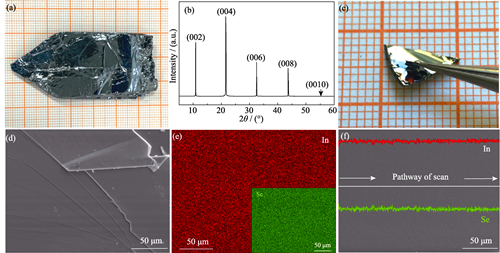
|
|
|
Mo/S Co-doped Graphene for Ammonia Synthesis: a Density Functional Theory Study
LI Honglan, ZHANG Junmiao, SONG Erhong, YANG Xinglin
2024 Vol. 39 (5): 561–568
 Abstract
Abstract(
193 )
 HTML
HTML(
9)
 PDF
PDF(2632KB)(
210
)
In the industrial landscape, the well-established Haber-Bosch method is employed for the catalytic synthesis of ammonia (NH3) from hydrogen and nitrogen gases, necessitating elevated temperatures (400-600 ℃) and high pressures (150-300 atm, 1 atm= 0.101325 MPa). In response to the imperative to reduce energy consumption and environment impact imposed by this synthetic process, significant research efforts have converged on realizing NH3 synthesis under ambient conditions. This study delves into the realm of N2 electrocatalytic reduction to NH3, using density functional theory (DFT) calculations to explore the feasibility of employing graphene co-doped with a combination of transition metal elements (e.g., Fe, Nb, Mo, W, and Ru) and non-metal elements (e.g., B, P, and S) as catalyst for ammonia synthesis. The findings underscore that Mo and S co-doped graphene (Mo/S graphene) demonstrates an exceptionally low electrode potential of 0.47 V for NH3 synthesis, with the key rate-controlling step centered around the formation of the intermediate *NNH. Especially, the ammonia synthesis potential is found to be lower than the hydrogen evolution potential (0.51 V), conclusively affirming the selectivity of nitrogen reduction to ammonia. Furthermore, through ab initio molecular dynamics calculations, the study attests to the remarkable thermodynamic stability of the Mo/S co-doped graphene system under room temperature conditions. Notably, electronic structure analysis validates that the ability of electron communication of the transition metal plays a pivotal role in dictating the efficiency of N2 electrocatalytic reduction. It can be tactically optimized through controlled modulation of the influence of the non-metal element on the coordination environment of the transition metal, thus substantially enhancing catalytic performance.
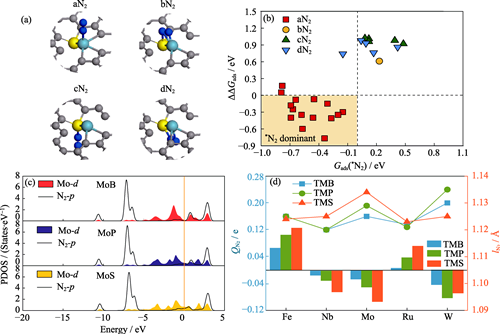
|
|